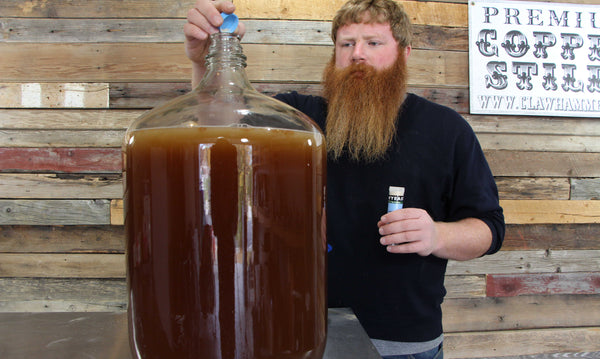
Apple “Moonshine” Recipe
If you want to make “apple moonshine” you need to start by making apple wine. When making apple wine the more acidic and sour varieties of apples are best (Winesap, McIntosh, and Jonathans all work great – but you can use any variety). Once you make the apple wine it can then be distilled and turned into apple moonshine.
Apple Wine Stats
- Starting Gravity: 1.065
- Ending Gravity: 1.000
- Wash Alcohol By Volume: (ABV) 8.5%
- Spirit ABV: 40% (80 Proof)
- Time to Ferment: 7 Days (can vary depending on yeast and temp)
- Fermentation temperature: 70F
Ingredients
- 25 pounds of ripe apples ( 1/2 bushel – we have a mixed variety of apples which works really well)
- 5-10 pounds cane sugar (1-2 pounds per gallon of mash)
- Enough water to reach 5 gallons of total liquid after juicing the apples
- 2.5 teaspoon yeast nutrient (Follow the directions on the label- most brands require 1/2 tsp per gallon)
- 1 packet dry wine yeast
Mashing Equipment
- Pleasant Hill MacIntosh Fruit Press 3-5 Gallon
- Pleasant Hill Maximizer Fruit Grinder
- 6.5 gallon fermenter with airlock
- Large pot for mashing
- Mash paddle or spoon
- Brewing/Wine hydrometer or refractometer
- Brewing thermometer
Mashing And Fermentation Process
- Pick 1/2 bushes of apples
- Wash the apples
- Add the apples to the apple grinder and grind
- Add the mash bag to the apple press
- Add the grinded apples to the fruit press
- Press the apples
- Collect the apple juice in a sterilized bucket
- Once all of the apples have been juiced add the juice to the mash pot
- Add 4 gallons of water (or enough to reach 5.5 gallons total volume)
- Mix the apple juice and water together
- Take a gravity reading
- Write down the gravity reading (Our original gravity was 1.013)
- You can go ahead and start heating at this point.
- Add 4-10 pounds of cane sugar while the mixture is heating up (you want to have a starting gravity around 1.065)
- Take another gravity reading it should be somewhere around 1.065. If the starting gravity is low keep adding sugar until the starting gravity is around 1.065. ( The wine will yield 8.5% if it ferments down to 1.000 )
- Cool the mash to 70 degrees with a wort chiller and siphon the mash into a 6.5 gallon fermenter
- Re-hydrate yeast if the package requires it
- Add the yeast to the fermenter
- Add 2.5 teaspoon yeast nutrient (Follow the directions on the label- most brands require 1/2 tsp per gallon)
- Add an airlock to a fermentation vessel and ferment in a dark location between 65-86 degrees (depending on the yeast strain) until fermentation is finished. (I ferment around 70 degrees as that is the current temperature in the basement)
Apple Moonshine Distillation Process
- After fermentation, transfer the apple wine to a 5 gallon bucket with an auto-siphon. Transfer only the liquid to the copper still, leave behind the yeast and other sediment.
- Make tight heads and tails cuts.
- Commercial distillers would set the hearts aside to be aged (for a premium product) or even conusmed without any doctoring. They might even “stretch” the amount of consumable product by mixing a bit of the heads and and a fair amount of the tails (nearest to the hearts) with the hearts. They would most likely age this product because aging smooths out much of the harshness of the heads and tails. Most distillers don’t age for any particular amount of time. They age “until it tastes right.” During the aging process they’ll taste the product from time to time to see how it is progressing, as the last thing they want to do is “over oak” the product.
from ClawHammerSupply




















